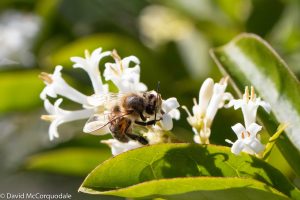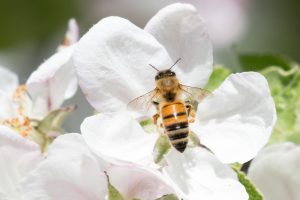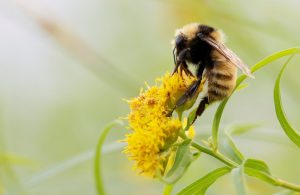3 To bee or not to bee?
What’s another name for a wasp? A wanna-bee.
Did you know that honey bees and bumble bees are very different from one another? In fact, honey bees are not native to North America and their presence can harm native bumble bee populations. Honey bees are managed livestock and they are farmed just like cows or chickens. Therefore, they are not even wild at all!
One of the main reasons honey bees are so popular is because they produce a sweet treat that a lot of people enjoy…honey! Many farmers bring honey bees to their farms in hopes of increasing pollination for their crops. What many people do not realize is that honey bees are not the most efficient pollinators for your gardens. In fact, there are lots of other insects aside from honey bees that are excellent pollinators. So who might be one of the best pollinators for your garden you might ask? Bumble bees of course!

Honey bees are not as tolerant of colder climates and they do not tend to pollinate in cool weather conditions. Additionally, honey bees have short tongues which means they cannot pollinate as many different types of flowers as a variety of bumble bee species could in a biodiverse ecosystem.
Bumble bees, however, are resilient pollinators that are built to withstand cold climates. They can be found foraging in both rain and shine and they typically start foraging much earlier in the day than honey bees. Bumble bees can pollinate quickly, for a longer period of time, and they are able to pollinate a wider variety of native plants and crops.
Can you identify a honey bee from a bumble bee?
| Honey bee | Bumble bee |
| Honey bees are slimmer and smaller than most bumble bees (similar to a wasp). | Bumble bees are usually larger, furrier, and more rounded. |
| There is only one species of honey bee that is found in Cape Breton. The Western honey bee (Aspis mellifera) was introduced to North America from Europe and only lives in hives managed by people. | There are about a dozen species of bumble bees in Cape Breton that come in different shapes and sizes.. |
| Western honey bees have short tongues meaning they are only able to forage on flowers that are more open in shape. | Since there are many different species of bumble bees, they all have different tongue lengths. Some longer and some shorter. This means that different species of bumblebees forage on different shaped flowers. This allows for more pollination on a wider variety of crops and plants. |
 Source: Steven McGrath (2019),view page. Source: Steven McGrath (2019),view page. |
 Source: Marian Whitcomb (2020), view site. Source: Marian Whitcomb (2020), view site. |
Let’s put what we have learned thus far to the test. In these multiple choice quizzes, can you identify if an individual is a honey bee or a bumble bee?
Apis mellifera. A non native species of bee that was introduced to Canada by humans. These bees are used in commercial settings and they are farmed for their honey production.
The transport of pollen from one plant to another is a major part of a plant's life cycle. While foraging, pollen brushes onto bumble bees and as they fly from flower to flower of the same species, they fertilize the plants as they go. Plants that are pollinated can produce seeds which means more plants will grow. For more information visit The Eden Project.
A geographic area where plants, animals, and other organisms, as well as weather and landscapes, work together to form a bubble of life (Source: National Geographic. Visit Site)
The action of a bumble bee gathering pollen and nectar.

